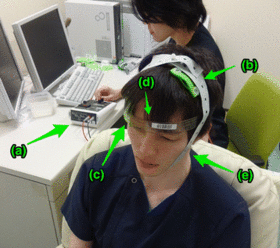Transcranial electric stimulation
| Transcranial direct-current stimulation | |
|---|---|

tDCS administration. Anodal (b) and cathodal (c) electrodes with 35-cm2 size are put on F3 and right supraorbital region, respectively. A head strap is used (d) for convenience and reproducibility, and a rubber band (e) for reducing resistance.
|
|
| MeSH | D065908 |
Transcranial direct current stimulation (tDCS) is a form of neurostimulation that uses constant, low current delivered to the brain area of interest via electrodes on the scalp. It was originally developed to help patients with brain injuries or psychiatric conditions like major depressive disorder. tDCS appears to have some potential for treating depression. However, there is no good evidence that it is useful for cognitive enhancement in healthy people, memory deficits in Parkinson's disease and Alzheimer's disease,schizophrenia, non-neuropathic pain, nor improving upper limb function after stroke.
tDCS appears to be somewhat effective for depression.
The adverse effects associated with tDCS appear to be mostly limited to headaches and itchiness and redness at the site of stimulation. When applied following established safety protocols, transcranial direct current stimulation is widely regarded as a safe method of brain stimulation. Safety protocols limit the current, duration, and frequency of stimulation, thereby limiting the effects and risk.
There has been much work done in the last 10 years to develop a safety protocol for administering transcranial direct current stimulation. Many studies have been conducted to determine the optimal time of stimulation and current used as well as steps to take in order to reduce or eliminate the side effects felt by the person receiving the stimulation. Present safety guidelines on the research and medical fields treat daily stimulation up to 60 min and up to 4 mA as safe. However, the tolerability of every day application for more than 10 sessions per two weeks remains unclear.
Studies have been completed to determine the current density at which overt brain damage occurs in rats. It was found that in cathodal stimulation, a current density of 142.9 A/m2 delivering a charge density of 52400 C/m2 or higher caused a brain lesion in the rat. This is over two orders of magnitude from what is currently being used.
...
Wikipedia
